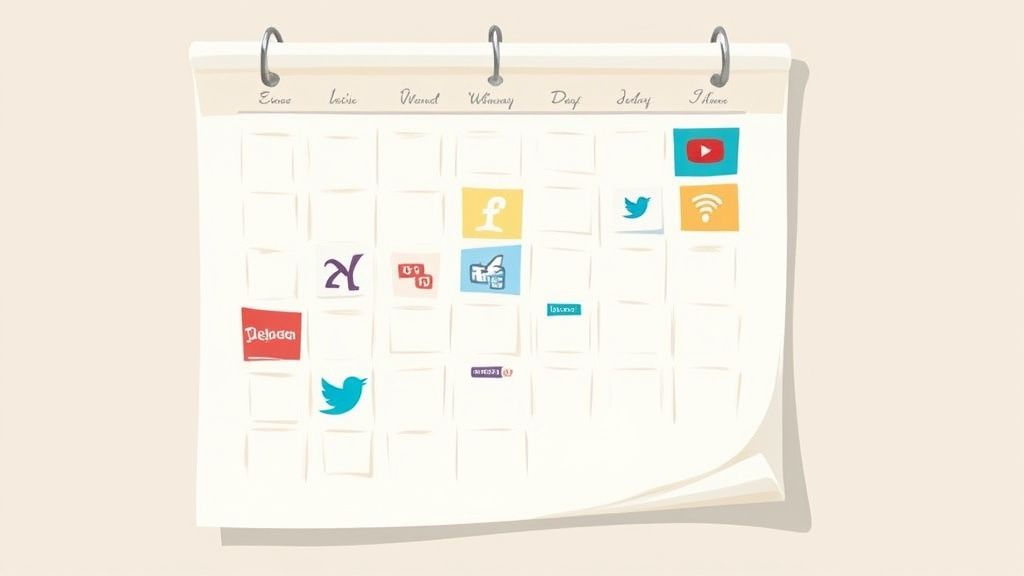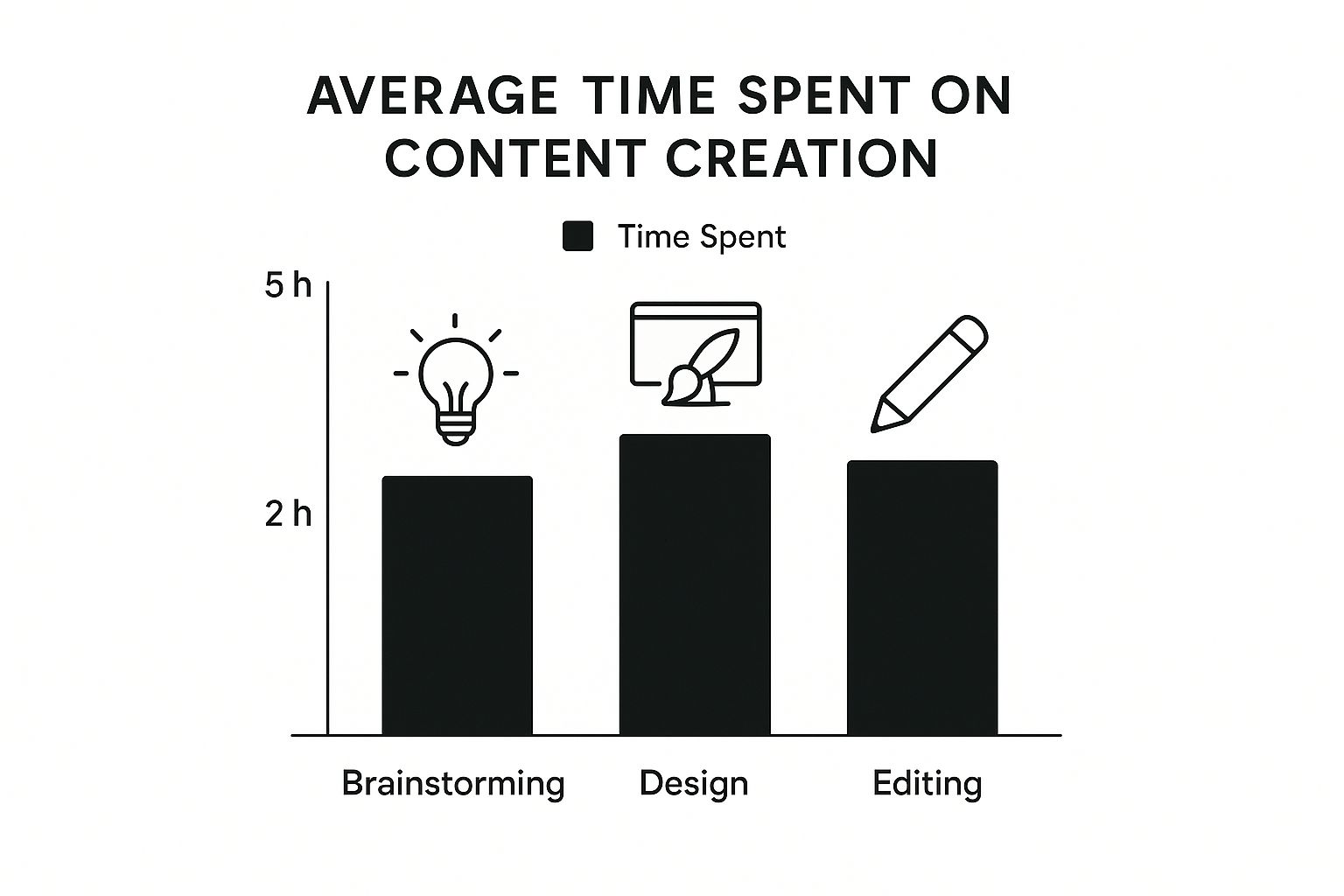Master Your Social Media Workflow for Better Results

The Evolution of Effective Social Media Workflows
The social media world requires a more thoughtful approach than simply posting randomly. Successful brands have moved past spontaneous tactics and adopted strategic social media workflows to achieve consistent positive outcomes. This change reflects the increasing importance of social media in our everyday lives. For instance, recent data reveals that 5.24 billion people actively use social media platforms as of early 2025.
The average user spends over two hours daily engaging with these platforms. This widespread use highlights the need for organized processes to manage social media activities efficiently. Want more in-depth statistics? Check out the Digital 2025 Global Overview Report.
From Chaos to Control: Why Workflows Matter
Many businesses initially treated social media as a secondary concern. However, as social platforms became essential for communication and marketing, the drawbacks of disorganized approaches became evident. Missed posting opportunities, inconsistent brand messaging, and difficulties tracking results are all signs of a flawed social media workflow.
This realization prompted the creation of more structured systems. Businesses began to recognize that a well-defined workflow could improve efficiency, enhance brand consistency, and ultimately drive better results. The shift towards structured workflows represents a maturation of the social media landscape.
Key Components of a High-Performing Workflow
Effective social media workflows share some fundamental elements:
- Clear Objectives: Defining specific, measurable, achievable, relevant, and time-bound (SMART) goals.
- Content Calendar: Planning and scheduling content ahead of time ensures consistent posting.
- Role Definition: Assigning clear responsibilities to team members for content creation, scheduling, and community management.
- Approval Processes: Establishing workflows for reviewing and approving content before it goes live.
- Performance Analysis: Regularly tracking key metrics to understand successes and areas for improvement.
These components work in concert to create a streamlined process that maximizes both efficiency and impact. Imagine it like an assembly line: each step contributes to the final product, ensuring both quality and consistency. This structured approach eliminates guesswork and allows teams to focus on creating engaging content.
The Psychological Benefits of Structure
Beyond the practical advantages, structured social media workflows provide important psychological benefits. For content creators, a structured process reduces the constant pressure to generate new ideas, encouraging more creativity. Clear workflows also enhance team collaboration by minimizing confusion and fostering a sense of shared responsibility.
This leads to improved team morale and reduces burnout. Ultimately, a well-defined social media workflow allows teams to achieve more with less stress. It empowers them to work smarter, not harder, and to find greater fulfillment in their social media efforts.
Designing Your Content Creation Engine
Moving beyond occasional posts requires a content creation engine that consistently produces engaging material. This means a structured approach, balancing quality content with the demands of a busy social media calendar. Successful brands recognize the importance of a robust content pipeline, functioning smoothly like a well-oiled machine, with each component contributing to the final result.
Establishing Your Content Pillars
First, define your content pillars. These are the core themes or topics that align with your brand and resonate with your audience. Content pillars provide the framework for all your content creation, ensuring consistency and relevance. For example, a fitness brand might select pillars like "nutrition," "workout routines," and "motivation." This gives them a clear direction for brainstorming content ideas and helps maintain a focused brand message.
The Power of Batch Creation
Batching, creating multiple pieces of similar content in one focused session, dramatically improves efficiency. Think of it as meal prepping for your social media channels. You dedicate a block of time to creating a variety of content around a specific theme, then schedule it for release over the week or month. This minimizes distractions and allows creators to enter a state of flow, resulting in higher quality output. Learn more in our article about 7 Types of Content to Boost Your Presence on LinkedIn.
Balancing Planned and Reactive Content
While a content calendar provides structure, it’s essential to leave room for reactive posting. Trends and current events present valuable opportunities for engagement. For example, if a major industry event takes place, adjusting your schedule to incorporate related content can significantly increase visibility. This necessitates balance: adhering to your plan for consistent messaging while staying flexible enough to capitalize on timely opportunities.
Resource Allocation for Content Creation
Resource allocation plays a vital role in social media workflow success. Even small teams can achieve great results by strategically dividing tasks based on individual strengths. Clearly defined roles, whether for writing, graphic design using tools like Adobe Photoshop, or community management, ensure everyone understands their contributions and avoids duplicated work. This clarity promotes efficiency and maximizes the impact of each team member's skillset.
Real-World Examples of Effective Workflows
Different organizations use different approaches. Some prioritize detailed planning, while others prefer a more flexible, adaptable system. A large corporation might have a complex, multi-stage approval process, while a small startup might use a simpler system. The key is finding a workflow that aligns with your team’s size, resources, and objectives. A successful social media workflow empowers your team to create high-quality content consistently, driving engagement and achieving measurable results.

Smart Automation That Doesn't Sound Robotic
Scheduling posts is a fundamental aspect of any social media workflow. However, simply filling a queue isn't enough. Savvy social media managers understand that automation should enhance, not replace, authentic engagement. This means developing a strategic approach that goes beyond generic best practices to find what truly resonates with your specific brand and audience.
Finding Your Optimal Publishing Cadence
Forget arbitrary rules when it comes to posting frequency. Instead, consider platform algorithms and your audience's behavior. Fast-paced platforms like Twitter might benefit from multiple daily posts. Meanwhile, a visually driven platform like Instagram might see better results with fewer, high-quality visuals. Experimentation is key: test different posting frequencies to find what works best for your audience and drives the most engagement. This data-driven approach ensures your content reaches the right people at the right time.
Content scheduling plays a significant role in successful social media management. Automation tools like Hootsuite and Buffer handle 60-70% of branded posts in major markets. Furthermore, enterprises dedicate 15-25% of their marketing budgets to workflow automation, particularly for cross-platform publishing. You can find more detailed statistics here.
Building Flexibility into Your Automated Workflow
While scheduling provides structure, it's essential to stay adaptable. Build mechanisms into your workflow to adjust pre-planned content. For instance, a sudden trending topic or unexpected news event might require a quick post outside your regular schedule. This means having clear guidelines for when to deviate from the plan and empowering your team members to make real-time decisions.
Streamlining Approvals and Handling Contingencies
Establish clear approval processes for social media content to maintain quality control without creating bottlenecks. Depending on your team's structure, this could involve a designated approver or a multi-stage review process. Contingency planning is equally important. Automation systems can occasionally fail, so having backup plans, like manual posting options, ensures your workflow isn't entirely disrupted by technical glitches.
The Human Element: What Not to Automate
While automation offers greater efficiency, some aspects of social media should always be human-driven. Direct interactions with your audience, like responding to comments and messages, require a personal touch. Authentic engagement builds trust and fosters a sense of community, which is impossible to replicate with automation. Striking the right balance between efficiency and genuine connection is crucial for a successful social media strategy. The following data chart illustrates the optimal balance between automation and human interaction across various social media tasks.

This data chart breaks down the suggested ratio of automation to human interaction for different social media tasks. As you can see, tasks like scheduling and reporting can be heavily automated, while community management and crisis communication require significant human involvement. The key takeaway is to identify tasks that benefit most from automation and those that need a human touch. This nuanced approach maximizes efficiency without sacrificing the authentic engagement that builds strong audience relationships.
The table below provides a detailed comparison of leading social media scheduling tools, highlighting key features and pricing to help you find the platform that best suits your needs.
Social Media Scheduling Tool Comparison
| Tool | Supported Platforms | Key Features | Price Range | Best For |
|---|---|---|---|---|
| Hootsuite | Twitter, Facebook, Instagram, LinkedIn, YouTube, Pinterest | Content scheduling, analytics, team collaboration, social listening | $99 - $739/month | Businesses of all sizes |
| Buffer | Twitter, Facebook, Instagram, LinkedIn, Pinterest | Content scheduling, analytics, engagement tools, link shortening | $15 - $99/month | Small to medium businesses and individuals |
| SproutSocial | Twitter, Facebook, Instagram, LinkedIn, Pinterest, YouTube | Content scheduling, analytics, social listening, CRM, advocacy | $249 - $499/month | Medium to large businesses |
| Later | Instagram, TikTok, Pinterest, Twitter, Facebook, LinkedIn | Content scheduling, visual planning, hashtag suggestions, linkin.bio | $18 - $40/month | Businesses focused on visual platforms |
| MeetEdgar | Twitter, Facebook, Instagram, LinkedIn | Content recycling, category-based scheduling, automated variations | $49/month | Businesses with a large content library |
This table summarizes the key features and pricing of popular social media scheduling tools. Choosing the right tool depends on your specific needs and budget, but understanding the options available is the first step towards efficient and effective social media management.
Analytics That Actually Improve Your Content

Forget vanity metrics like follower count. To truly elevate your social media game, you need to understand which data actually fuels your social media workflow. This means prioritizing actionable insights that directly shape your content strategy and overall social media performance. Successful brands don't just gather data; they weave its analysis into their daily operations. This constant feedback loop allows them to adapt and refine their content based on real-world results.
Identifying Key Metrics for Your Business Objectives
Not all metrics hold the same weight. The most valuable metrics are determined by your specific business goals. If brand awareness is your primary objective, reach and impressions are paramount.
However, if lead generation is your focus, website clicks and conversion rates become more significant. This targeted approach ensures you're tracking the data that truly aligns with your business needs. Data-driven decision-making is now a cornerstone of social media workflows.
In fact, one-third of users worldwide access platforms specifically to consume news. By 2025, platforms like Instagram and TikTok are expected to prioritize AI-driven analytics dashboards. These dashboards will provide real-time engagement rates (often 2-5% per post) and detailed demographic breakdowns. Find more detailed statistics here.
To help illustrate which metrics to prioritize, let's take a look at the table below:
Essential Social Media Metrics by Business Goal
A breakdown of which metrics to track based on different business objectives
| Business Goal | Primary Metrics | Secondary Metrics | Measurement Frequency |
|---|---|---|---|
| Brand Awareness | Reach, Impressions | Engagement (likes, shares, comments) | Weekly |
| Lead Generation | Website Clicks, Conversion Rates | Cost Per Lead (CPL) | Daily/Weekly |
| Community Building | Engagement (comments, shares), Active Followers | Growth Rate | Weekly/Monthly |
| Sales | Conversions, Revenue Generated | Customer Lifetime Value (CLTV) | Daily/Weekly |
As you can see, choosing the right metrics can significantly impact your strategy. Focusing on the metrics aligned with your specific goals provides a clear path to measure success.
Setting Benchmarks That Reflect Real Progress
Establishing meaningful benchmarks is essential for gauging progress. Instead of chasing arbitrary numbers, analyze your past performance and industry averages to set realistic, achievable goals. This approach provides a clear framework for tracking improvement and identifying areas that need attention.
For instance, if your average engagement rate has been 1%, aiming for a 2% increase is a more attainable benchmark than expecting a sudden surge to 10%.
Content Auditing for Actionable Insights
Content auditing is a powerful process for uncovering patterns in your top-performing content. By examining your most successful posts, you can pinpoint what resonates with your audience and replicate those wins.
This might involve identifying effective content formats, recurring themes, or specific hashtags that consistently drive engagement. 10 Proven Content Repurposing Strategies to Boost ROI offers more valuable information on this topic. This analysis provides valuable, data-driven insights to shape your future content strategy.
Implementing Testing Protocols for Continuous Improvement
A/B testing different variations of your content helps refine your approach. Experiment with different headlines, visuals, or calls to action to see what resonates best with your audience.
By systematically testing various elements, you can pinpoint what drives the most engagement and continually optimize your social media presence. This iterative process ensures your content is constantly evolving and improving based on live data.
Balancing Data with Creative Intuition
While data plays a crucial role, never underestimate the power of creative intuition. Don’t let data stifle your creativity; instead, use it as a guide.
Use data to inform your creative decisions, but don’t be afraid to experiment and try new things. Maintaining this balance ensures that your content stays fresh, engaging, and authentic to your brand voice. Data and creativity, when combined effectively, create a powerful and impactful social media strategy.
Building Team Workflows That Actually Work

Effective social media workflows are more than just project management software. They thrive on genuine team collaboration. This section explores how successful social media teams structure their workflows for maximum creativity and efficiency. It's a delicate balance that requires careful planning of roles, approvals, and crisis management.
Defining Roles and Responsibilities
Assigning clear roles based on individual strengths is essential. This means identifying team members' talents in content creation, data analysis, and community engagement. For example, a strong writer could create captivating captions and blog posts. Someone with a visual eye could focus on image and video creation using platforms like Canva. Clearly defined roles prevent confusion and duplicated work, ensuring a smooth social media workflow.
Establishing Efficient Approval Processes
Approval processes ensure quality control, but they can become bottlenecks if poorly designed. The key is balancing oversight and speed. One effective method is tiered approvals. Junior team members approve routine content, while senior staff review sensitive material. This streamlines the process, preventing delays and ensuring timely content delivery.
Crisis Management in Your Social Media Workflow
Social media crises can arise unexpectedly. A clear crisis management plan within your social media workflow is crucial. This plan should outline designated spokespeople, communication channels, and pre-approved messaging for common crises. A well-defined protocol enables quick, effective responses to minimize damage and maintain a positive brand image.
Integrating Freelancers and Agencies
Many teams utilize freelancers or agencies. Successfully integrating them into your social media workflow requires clear communication and established expectations. Set clear deadlines, provide detailed brand guidelines, and schedule regular check-ins. These practices ensure consistent brand voice and a seamless workflow, even with external partners.
Communication Cadences and Service Level Agreements
Open communication is essential for a successful social media workflow. Establish clear communication schedules for team meetings, progress updates, and feedback sessions. This keeps everyone informed and aligned with goals. Service Level Agreements (SLAs), defining expected response times for various tasks, enhance efficiency and prevent project delays.
Setting Realistic Expectations and Avoiding Burnout
Finally, set realistic expectations for your team. Social media is a 24/7 world, but your team shouldn't work around the clock. Prioritize tasks, delegate effectively, and encourage time off to prevent burnout. A happy, healthy team is a productive team. Implementing these strategies builds a social media workflow that delivers results and fosters a positive work environment. This approach enables continuous improvement and long-term success in the ever-changing social media world.
Connecting Social Workflows to Business Outcomes
Social media has evolved. It's no longer just about marketing; it's a core business function. Smart companies are weaving their social media workflows into their overall operations. This allows them to leverage social insights to improve different areas of their business, from creating better products to providing exceptional customer service.
Feeding Social Insights into Other Business Functions
Connecting social workflows to business outcomes hinges on establishing feedback loops. These loops ensure that valuable information gathered from social media is shared with the right teams. For instance, customer comments on social media can be incredibly helpful in shaping product development decisions. Keeping an eye on social conversations can also reveal emerging customer service problems, allowing for proactive intervention.
You might be interested in: Understanding the 2024 LinkedIn Algorithm. This can be incredibly helpful for getting the most out of your social media strategy.
Integrating Social Data with Existing Systems
Integrating social data with existing business systems is another important piece of the puzzle. Think CRM platforms like Salesforce, email marketing software like Mailchimp, and e-commerce databases. This integration provides a much more complete view of the customer journey. Imagine tracking social media interactions alongside purchase history. This can reveal powerful insights into customer behavior.
This means marketing campaigns can be more effectively targeted, based on a deeper understanding of customer preferences. It's important, however, to avoid creating data silos. Choose tools and strategies that allow information to flow smoothly between different systems.
Improving Customer Satisfaction Through Social Integration
Connecting social workflows to customer service operations can dramatically improve response times and address customer concerns more effectively. Social listening tools can pinpoint customers who are having problems and direct them to the appropriate support channels. This proactive approach can really boost customer satisfaction and build loyalty.
Boosting Conversion Rates Through Social Data
Integrating social data with sales and marketing processes can significantly impact conversion rates. By understanding customer preferences and purchase history gleaned through social interactions, businesses can personalize marketing messages and suggest relevant products. This targeted approach can greatly increase the likelihood of conversions and improve overall sales performance.
Measuring the ROI of Integrated Social Workflows
Companies that effectively integrate social workflows with their core business functions often see measurable improvements in their marketing ROI. Tracking key metrics like conversions, customer lifetime value, and cost per lead helps businesses directly link revenue growth to their social media activities. This data-driven approach demonstrates the value of investing in social media and its positive impact on the bottom line.
Case Studies and Expert Insights
Many examples showcase the power of integrating social workflows with business outcomes. Companies that use social listening tools to gauge customer sentiment have seen improvements in product development and customer service. Organizations leveraging social data for targeted marketing campaigns have achieved higher conversion rates. These success stories clearly demonstrate the value of incorporating social media into broader business operations.
Transform your static content into engaging carousels that captivate your audience and drive results. Lumeo empowers you to effortlessly create dynamic visual presentations from various content formats, optimized for leading social platforms. With AI-driven tools, customizable branding, and flexible pricing, Lumeo is the perfect solution for maximizing your online visibility and business growth. Visit Lumeo today to explore how we can help you achieve your social media goals.